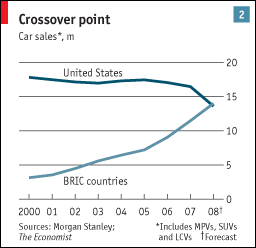
Two weeks ago, transportation researcher Michael Sivak brought us the news that there are fewer cars per person in the U.S. now than there were a few years ago – and that the number isn’t expected to rise again.
But globally, the trend is in the opposite direction, and it's alarming. The world is producing more cars than ever. A new report from the Worldwatch Institute shows that automobile production hit a new high in 2012 -- and 2013 is expected to surpass that record. “According to London-based IHS Automotive, passenger-car production rose from 62.6 million in 2011 to 66.7 million in 2012, and it may reach 68.3 million in 2013,” write Worldwatch’s Michael Renner and Maaz Gardezi. “When cars are combined with light trucks, total light vehicle production rose from 76.9 million in 2011 to 81.5 million in 2012 and is projected to total 83.3 million in 2013.”
The troubling new reality is that while the United States and other developed countries are beginning to lay off the gas, other countries are accelerating wildly. Though the U.S. still has by far the largest fleet of passenger cars, auto sales in China overtook the U.S. in 2011. In 2010, the number of cars in the world hit one billion.

The number of cars per person in the U.S. has been declining since 2006. But in other countries, the trend is ever upward. According to World Bank data, there were 18 passenger cars per 1,000 Chinese in 2006 and 44 cars per 1,000 in 2010. The Arab world and Eastern Europe have seen tremendous growth in private car ownership over the same period – from 87 to 123 cars per thousand people in Jordan, 18 to 36 in Syria, 230 to 345 in Bulgaria, 351 to 451 in Poland. In the meantime, U.S. rates declined from 453 to 423 per thousand. France, New Zealand, and the United Kingdom also saw declines.
In 2011, the OECD's International Transport Forum forecast that the number of cars worldwide would reach 2.5 billion by 2050, with the growth expected to be almost entirely in the developing world. At an ITF meeting, a Chinese professor dismissed the idea of bicycles as an alternative means of transportation, despite the fact that China is famous for its bicycle rush hour. The professor said, apparently without irony, that bicycle use in Beijing is declining “due to poor air quality and the danger from car traffic.”
Meanwhile, a member of India’s Planning Commission derided cycling as “a miniscule thing,” saying, “That’s not the future.”
For what it's worth, fuel economy in other countries tends to be better than in the United States. Japan, the European Union, and India have far stricter limits on carbon emissions than the U.S., according to Worldwatch. Chinese emissions standards are currently about the same as U.S. standards for cars, but if you add in other light-duty vehicles, Chinese standards come out far better. And the emissions standards that China is currently studying would put it way out in front of the United States.
But developing nations have higher levels of vehicle ownership now than wealthy nations did at similar income levels, according to a 2012 article in The Economist, “because their transport infrastructure has developed faster than it did in richer countries, cars are cheaper in real terms and urbanisation is happening faster.”
Will these countries repeat the American mistake of building out too many highways and designing roads only to move cars. There are reasons to hope that the developing world won’t get weighed down with excessive sprawl and traffic, despite booming car sales. Their infrastructure won’t tolerate a massive influx of cars -- car congestion is already overwhelming in some places. (Remember China’s 11-day traffic jam in 2010?) A recent story about Chinese bike-share systems in the English-language paper China Daily hints that the tide may already be turning away from car-based transport.
As Chen Yanyan, a professor at the Beijing University of Technology's transport research center, told the paper: "It's natural that people will figure out a solution when the traffic jams and environmental pollution reach a certain point."





